Abstract
To improve the understanding of the relative importance of serotypes of rotavirus in dehydrating diarrhea, we examined the correlation of clinical characteristics and disease severity with serotype in 2,441 diarrheal episodes among children younger than 2 years of age in rural Bangladesh. Of 764 rotavirus-associated episodes, a single G type (serotype 1, 2, 3, or 4) was determined by oligonucleotide probe in 485 (63%), while 233 episodes were nontypeable. Episodes with G types 2 and 3 were associated with more-severe dehydration than episodes associated with G type 1 or 4 or with nontypeable rotavirus. Episodes did not differ by G type in prevalence of vomiting, copious diarrhea, fever, abdominal pain, or length of treatment center stay. Rotavirus reinfections were detected in seven children, with homologous reinfection (G type 2) in one. Twelve children with diarrhea who died had rotavirus detected in stool specimens within 30 days of death. Children who died were more likely to be malnourished than were surviving children with rotavirus diarrhea. Of 40 specimens tested by polymerase chain reaction, 29 (72.5%) were P type 1, 9 (22.5%) were P type 2, 1 (2.5%) was P type 3, and 1 (2.5%) was nontypeable. One severely symptomatic diarrheal episode was associated with P type 3 rotavirus, a serotype usually found in asymptomatic nursery infections. Although G types 2 and 3 were associated with more-severe dehydration than other serotypes, the differences do not appear to be of major clinical importance. Effective vaccines should protect against all four major G types.
Full text
PDF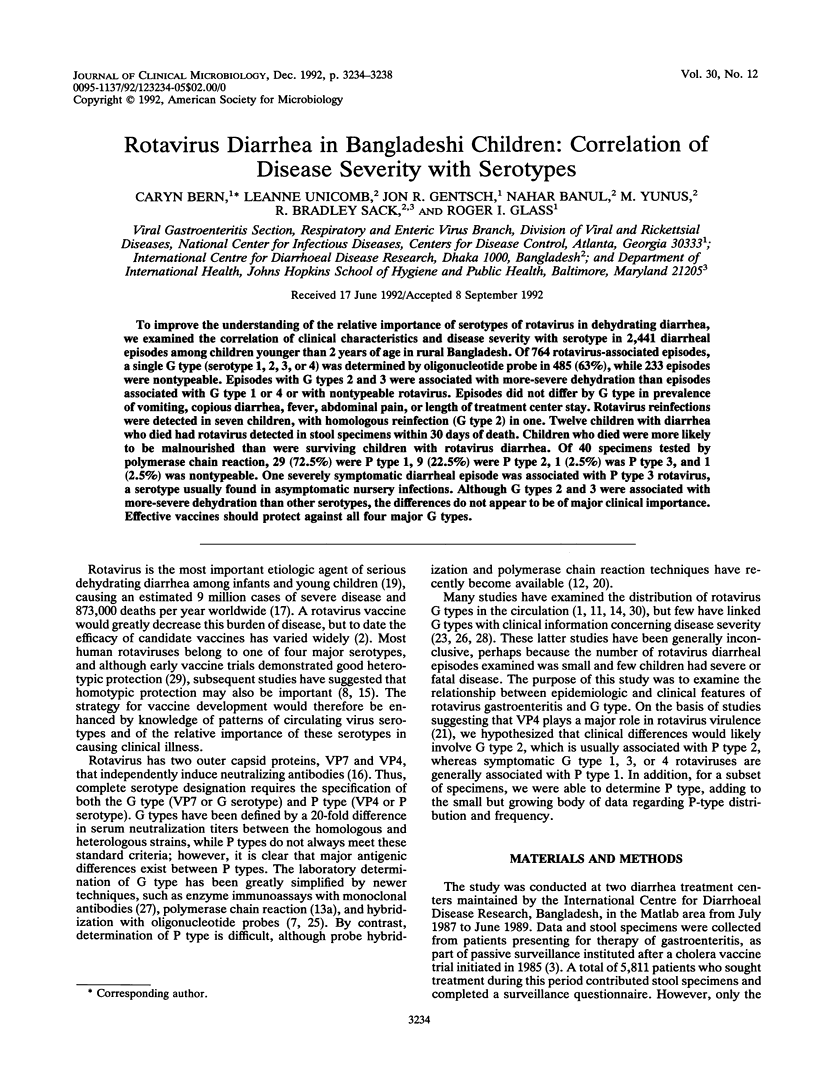
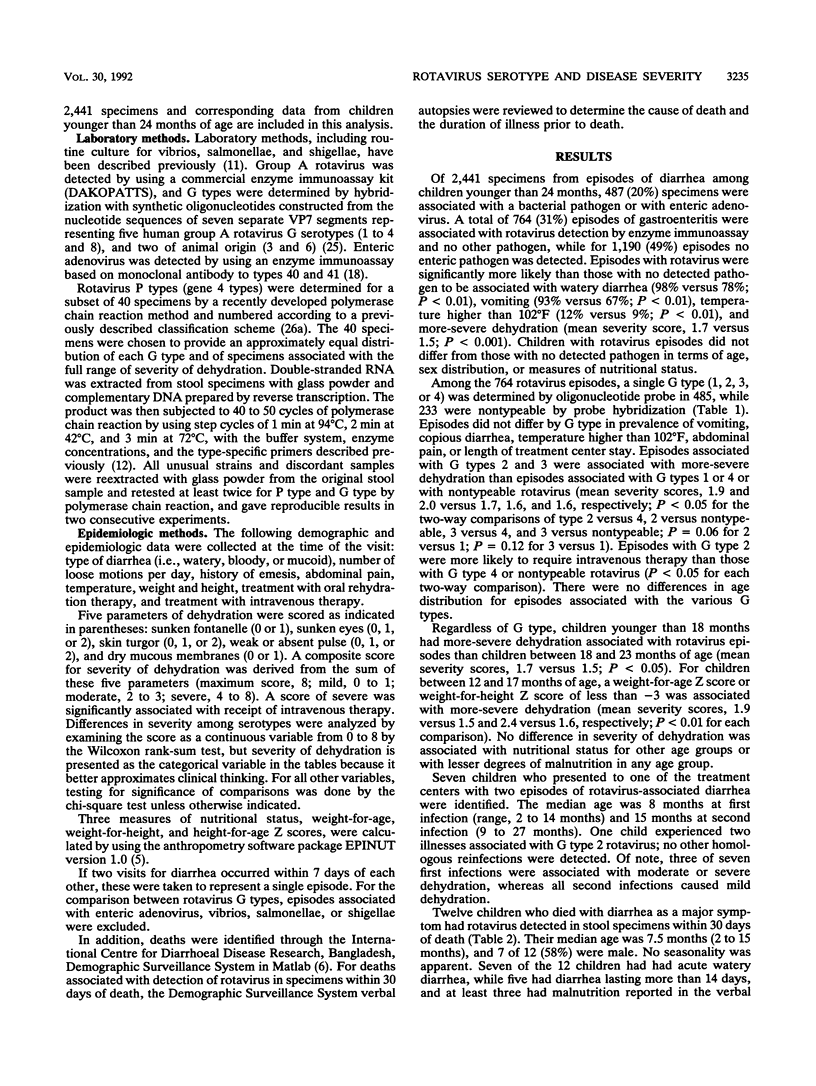
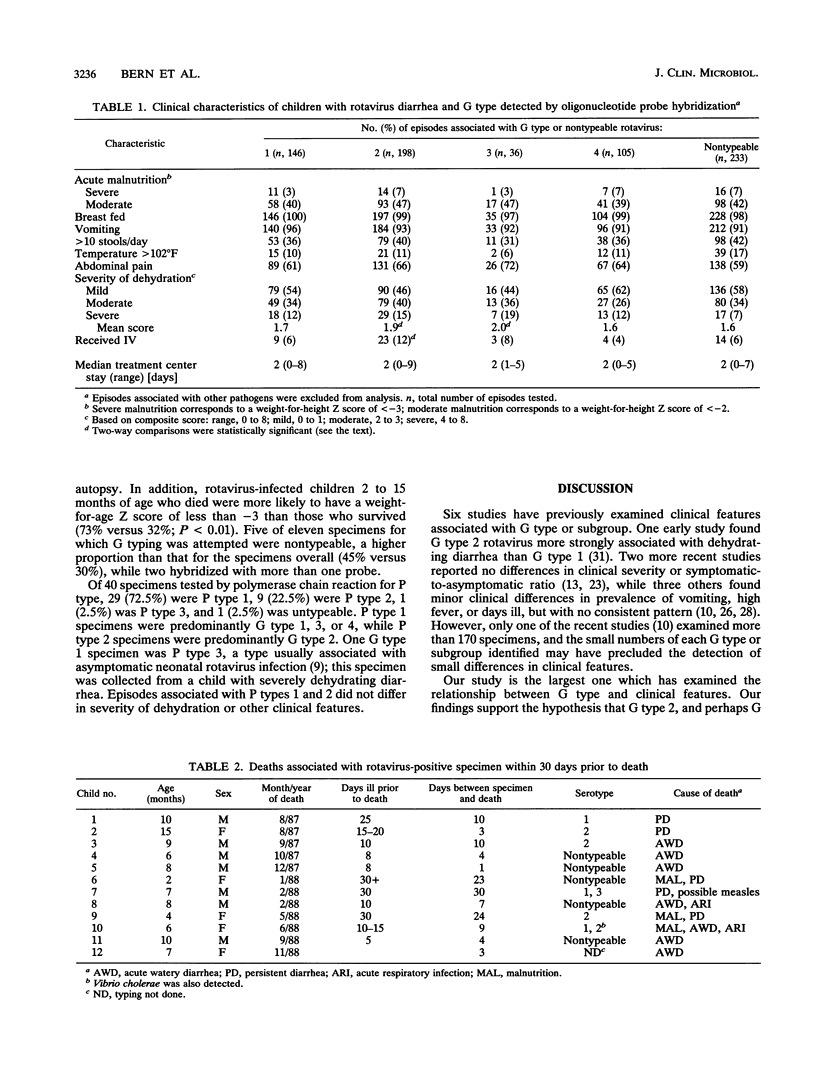
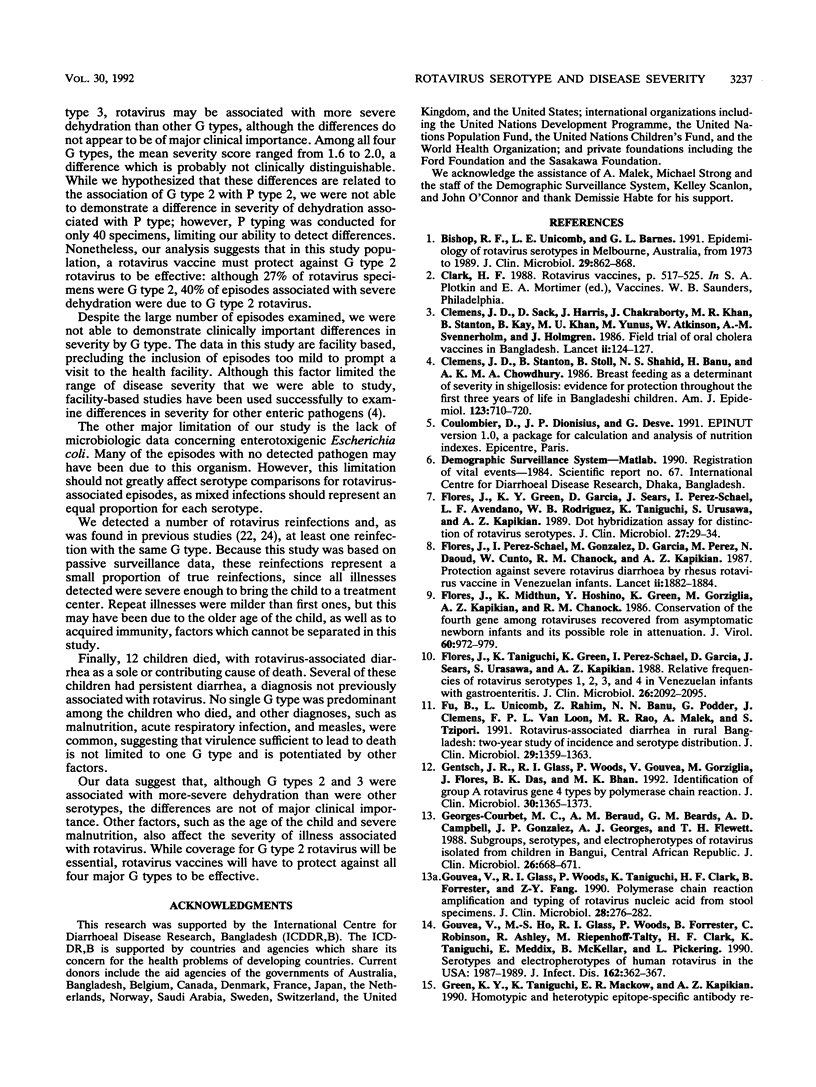
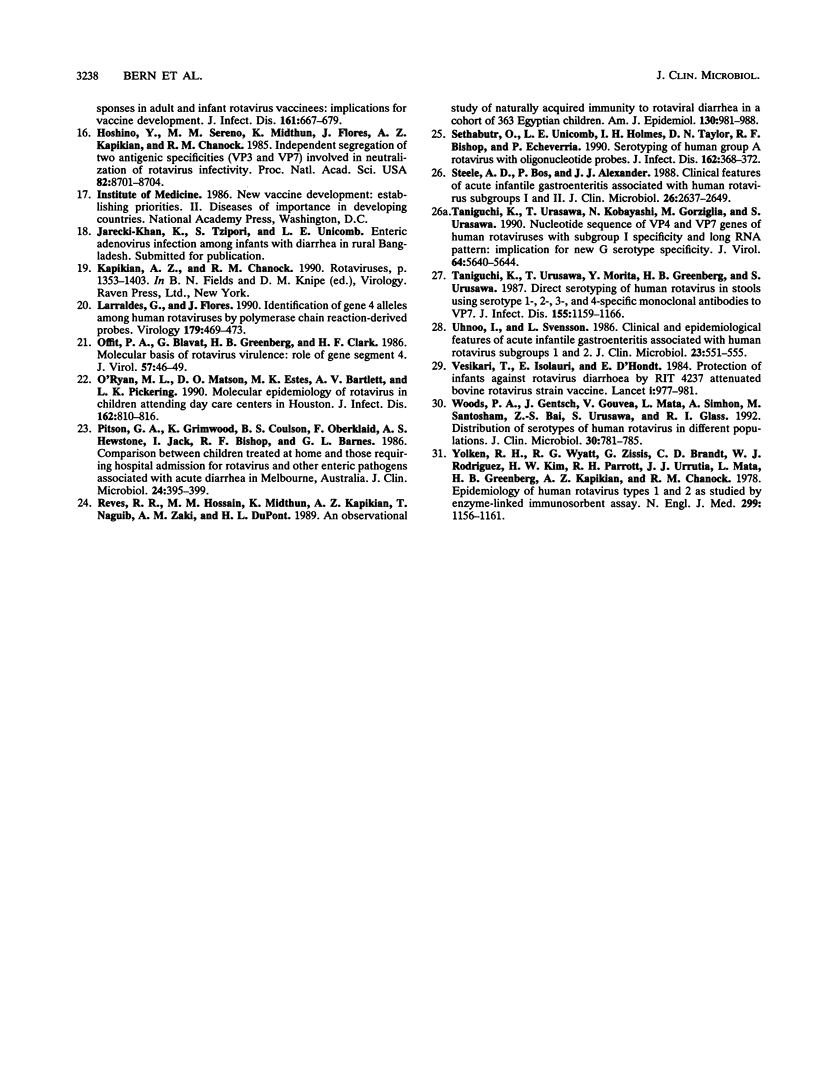
Selected References
These references are in PubMed. This may not be the complete list of references from this article.
- Bishop R. F., Unicomb L. E., Barnes G. L. Epidemiology of rotavirus serotypes in Melbourne, Australia, from 1973 to 1989. J Clin Microbiol. 1991 May;29(5):862–868. doi: 10.1128/jcm.29.5.862-868.1991. [DOI] [PMC free article] [PubMed] [Google Scholar]
- Clemens J. D., Sack D. A., Harris J. R., Chakraborty J., Khan M. R., Stanton B. F., Kay B. A., Khan M. U., Yunus M., Atkinson W. Field trial of oral cholera vaccines in Bangladesh. Lancet. 1986 Jul 19;2(8499):124–127. doi: 10.1016/s0140-6736(86)91944-6. [DOI] [PubMed] [Google Scholar]
- Clemens J. D., Stanton B., Stoll B., Shahid N. S., Banu H., Chowdhury A. K. Breast feeding as a determinant of severity in shigellosis. Evidence for protection throughout the first three years of life in Bangladeshi children. Am J Epidemiol. 1986 Apr;123(4):710–720. doi: 10.1093/oxfordjournals.aje.a114291. [DOI] [PubMed] [Google Scholar]
- Flores J., Green K. Y., Garcia D., Sears J., Perez-Schael I., Avendaño L. F., Rodriguez W. B., Taniguchi K., Urasawa S., Kapikian A. Z. Dot hybridization assay for distinction of rotavirus serotypes. J Clin Microbiol. 1989 Jan;27(1):29–34. doi: 10.1128/jcm.27.1.29-34.1989. [DOI] [PMC free article] [PubMed] [Google Scholar]
- Flores J., Midthun K., Hoshino Y., Green K., Gorziglia M., Kapikian A. Z., Chanock R. M. Conservation of the fourth gene among rotaviruses recovered from asymptomatic newborn infants and its possible role in attenuation. J Virol. 1986 Dec;60(3):972–979. doi: 10.1128/jvi.60.3.972-979.1986. [DOI] [PMC free article] [PubMed] [Google Scholar]
- Flores J., Taniguchi K., Green K., Perez-Schael I., Garcia D., Sears J., Urasawa S., Kapikian A. Z. Relative frequencies of rotavirus serotypes 1, 2, 3, and 4 in Venezuelan infants with gastroenteritis. J Clin Microbiol. 1988 Oct;26(10):2092–2095. doi: 10.1128/jcm.26.10.2092-2095.1988. [DOI] [PMC free article] [PubMed] [Google Scholar]
- Fun B. N., Unicomb L., Rahim Z., Banu N. N., Podder G., Clemens J., Van Loon F. P., Rao M. R., Malek A., Tzipori S. Rotavirus-associated diarrhea in rural Bangladesh: two-year study of incidence and serotype distribution. J Clin Microbiol. 1991 Jul;29(7):1359–1363. doi: 10.1128/jcm.29.7.1359-1363.1991. [DOI] [PMC free article] [PubMed] [Google Scholar]
- Gentsch J. R., Glass R. I., Woods P., Gouvea V., Gorziglia M., Flores J., Das B. K., Bhan M. K. Identification of group A rotavirus gene 4 types by polymerase chain reaction. J Clin Microbiol. 1992 Jun;30(6):1365–1373. doi: 10.1128/jcm.30.6.1365-1373.1992. [DOI] [PMC free article] [PubMed] [Google Scholar]
- Georges-Courbot M. C., Beraud A. M., Beards G. M., Campbell A. D., Gonzalez J. P., Georges A. J., Flewett T. H. Subgroups, serotypes, and electrophoretypes of rotavirus isolated from children in Bangui, Central African Republic. J Clin Microbiol. 1988 Apr;26(4):668–671. doi: 10.1128/jcm.26.4.668-671.1988. [DOI] [PMC free article] [PubMed] [Google Scholar]
- Gouvea V., Glass R. I., Woods P., Taniguchi K., Clark H. F., Forrester B., Fang Z. Y. Polymerase chain reaction amplification and typing of rotavirus nucleic acid from stool specimens. J Clin Microbiol. 1990 Feb;28(2):276–282. doi: 10.1128/jcm.28.2.276-282.1990. [DOI] [PMC free article] [PubMed] [Google Scholar]
- Gouvea V., Ho M. S., Glass R., Woods P., Forrester B., Robinson C., Ashley R., Riepenhoff-Talty M., Clark H. F., Taniguchi K. Serotypes and electropherotypes of human rotavirus in the USA: 1987-1989. J Infect Dis. 1990 Aug;162(2):362–367. doi: 10.1093/infdis/162.2.362. [DOI] [PubMed] [Google Scholar]
- Hoshino Y., Sereno M. M., Midthun K., Flores J., Kapikian A. Z., Chanock R. M. Independent segregation of two antigenic specificities (VP3 and VP7) involved in neutralization of rotavirus infectivity. Proc Natl Acad Sci U S A. 1985 Dec;82(24):8701–8704. doi: 10.1073/pnas.82.24.8701. [DOI] [PMC free article] [PubMed] [Google Scholar]
- Larralde G., Flores J. Identification of gene 4 alleles among human rotaviruses by polymerase chain reaction-derived probes. Virology. 1990 Nov;179(1):469–473. doi: 10.1016/0042-6822(90)90317-k. [DOI] [PubMed] [Google Scholar]
- O'Ryan M. L., Matson D. O., Estes M. K., Bartlett A. V., Pickering L. K. Molecular epidemiology of rotavirus in children attending day care centers in Houston. J Infect Dis. 1990 Oct;162(4):810–816. doi: 10.1093/infdis/162.4.810. [DOI] [PubMed] [Google Scholar]
- Offit P. A., Blavat G., Greenberg H. B., Clark H. F. Molecular basis of rotavirus virulence: role of gene segment 4. J Virol. 1986 Jan;57(1):46–49. doi: 10.1128/jvi.57.1.46-49.1986. [DOI] [PMC free article] [PubMed] [Google Scholar]
- Pitson G. A., Grimwood K., Coulson B. S., Oberklaid F., Hewstone A. S., Jack I., Bishop R. F., Barnes G. L. Comparison between children treated at home and those requiring hospital admission for rotavirus and other enteric pathogens associated with acute diarrhea in Melbourne, Australia. J Clin Microbiol. 1986 Sep;24(3):395–399. doi: 10.1128/jcm.24.3.395-399.1986. [DOI] [PMC free article] [PubMed] [Google Scholar]
- Reves R. R., Hossain M. M., Midthun K., Kapikian A. Z., Naguib T., Zaki A. M., DuPont H. L. An observational study of naturally acquired immunity to rotaviral diarrhea in a cohort of 363 Egyptian children. Calculation of risk for second episodes using age-specific person-years of observation. Am J Epidemiol. 1989 Nov;130(5):981–988. doi: 10.1093/oxfordjournals.aje.a115431. [DOI] [PubMed] [Google Scholar]
- Sethabutr O., Unicomb L. E., Holmes I. H., Taylor D. N., Bishop R. F., Echeverria P. Serotyping of human group A rotavirus with oligonucleotide probes. J Infect Dis. 1990 Aug;162(2):368–372. doi: 10.1093/infdis/162.2.368. [DOI] [PubMed] [Google Scholar]
- Steele A. D., Bos P., Alexander J. J. Clinical features of acute infantile gastroenteritis associated with human rotavirus subgroups I and II. J Clin Microbiol. 1988 Dec;26(12):2647–2649. doi: 10.1128/jcm.26.12.2647-2649.1988. [DOI] [PMC free article] [PubMed] [Google Scholar]
- Taniguchi K., Urasawa T., Kobayashi N., Gorziglia M., Urasawa S. Nucleotide sequence of VP4 and VP7 genes of human rotaviruses with subgroup I specificity and long RNA pattern: implication for new G serotype specificity. J Virol. 1990 Nov;64(11):5640–5644. doi: 10.1128/jvi.64.11.5640-5644.1990. [DOI] [PMC free article] [PubMed] [Google Scholar]
- Taniguchi K., Urasawa T., Morita Y., Greenberg H. B., Urasawa S. Direct serotyping of human rotavirus in stools by an enzyme-linked immunosorbent assay using serotype 1-, 2-, 3-, and 4-specific monoclonal antibodies to VP7. J Infect Dis. 1987 Jun;155(6):1159–1166. doi: 10.1093/infdis/155.6.1159. [DOI] [PubMed] [Google Scholar]
- Uhnoo I., Svensson L. Clinical and epidemiological features of acute infantile gastroenteritis associated with human rotavirus subgroups 1 and 2. J Clin Microbiol. 1986 Mar;23(3):551–555. doi: 10.1128/jcm.23.3.551-555.1986. [DOI] [PMC free article] [PubMed] [Google Scholar]
- Vesikari T., Isolauri E., D'Hondt E., Delem A., André F. E., Zissis G. Protection of infants against rotavirus diarrhoea by RIT 4237 attenuated bovine rotavirus strain vaccine. Lancet. 1984 May 5;1(8384):977–981. doi: 10.1016/s0140-6736(84)92323-7. [DOI] [PubMed] [Google Scholar]
- Woods P. A., Gentsch J., Gouvea V., Mata L., Santosham M., Bai Z. S., Urasawa S., Glass R. I. Distribution of serotypes of human rotavirus in different populations. J Clin Microbiol. 1992 Apr;30(4):781–785. doi: 10.1128/jcm.30.4.781-785.1992. [DOI] [PMC free article] [PubMed] [Google Scholar]
- Yolken R. H., Wyatt R. G., Zissis G., Brandt C. D., Rodriguez W. J., Kim H. W., Parrott R. H., Urrutia J. J., Mata L., Greenberg H. B. Epidemiology of human rotavirus Types 1 and 2 as studied by enzyme-linked immunosorbent assay. N Engl J Med. 1978 Nov 23;299(21):1156–1161. doi: 10.1056/NEJM197811232992103. [DOI] [PubMed] [Google Scholar]


